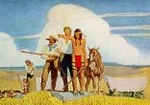
Worksheets and No Prep Teaching Resources
Reading Comprehension Worksheets
Wild, Wild West

Wild, Wild West
 Worksheets and No Prep Teaching Resources Reading Comprehension Worksheets Wild, Wild West |
 Wild, Wild West |
| edHelper's suggested reading level: | grades 4 to 5 | |
| Flesch-Kincaid grade level: | 6.33 |
|
Wagon Trains
By Jennifer Kenny |

|
 1 When we think of the development of the United States, we can't help but think of those who traveled across the country to settle the great lands of the West. What were their travels like? What images come to your mind when you think of this great migration? The wagon train is probably one of those images.
1 When we think of the development of the United States, we can't help but think of those who traveled across the country to settle the great lands of the West. What were their travels like? What images come to your mind when you think of this great migration? The wagon train is probably one of those images. |
Create Weekly Reading Books
Prepare for an entire week at once! |
| Leave your feedback on Wagon Trains (use this link if you found an error in the story) |
 |
Wild, Wild West
|
 |
United States
|
|
|
 | Fifty States Theme Unit |
 |
Document Based Activities |